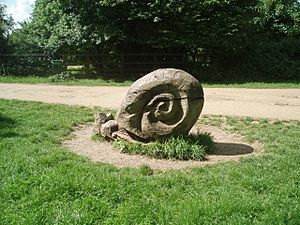Dinton Pastures Country Park facts for kids
Dinton Pastures Country Park is a fun and exciting country park located near Reading in England's Berkshire county. It's a great place to explore nature and enjoy outdoor activities!
Contents
What is Dinton Pastures Like?
This huge park covers about 450 acres (that's like 225 football fields!). It's home to seven beautiful lakes and two rivers, the River Loddon and the Emm Brook. You can also find three special bird hides, which are perfect spots to quietly watch birds. One of the lakes, Lavells Lake, is even a special local nature reserve, meaning it's protected for its wildlife.
Inside the park, you'll also find the Museum of Berkshire Aviation, where you can learn about airplanes. The main office for the British Entomological and Natural History Society is here too, which is a group that studies insects and nature.
The park is super popular for many sports and activities. You can go sailing, fishing (angling), kayaking, and canoeing on the lakes. There are also fun play areas for kids and a cozy cafe where you can grab a snack or a drink.
A Look Back in Time: Park History
Long, long ago, the Anglo-Saxons farmed the meadows along the river in this area. They called it Whistley, which meant "marshy meadows" and "woodland clearing."
Later, starting in the 1600s, much of the land became part of Windsor Forest.
The cafe you see today was once a farmhouse built in 1904. It was called 'High Chimneys'. In 1924, a farmer bought the land and named his farm 'Dinton' after his home village, Dinton, near Aylesbury. That's how the park got its name!
Dinton Pastures is on the River Loddon's flood plain. This means it's a good place to find gravel. Between 1969 and 1979, a lot of gravel was dug up from the park. This gravel was used to help build big roads like the M4 and the A329(M).
Finally, in 1979, Dinton Pastures was opened for everyone to enjoy. Then, in 1992, Lavells Lake was officially made a local nature reserve to protect its amazing wildlife.
Animals of Dinton Pastures
Dinton Pastures is a fantastic place to spot all sorts of animals!
Mammals
You might see different kinds of mammals here, including:
- European rabbits
- Red foxes
- Roe deer
- Muntjac deer
- Eastern grey squirrels
- And even different types of bats like the Soprano pipistrelle and Daubenton's bat.
Invertebrates (Insects and More!)
The park is buzzing with many invertebrates, especially dragonflies and butterflies!
- Anax imperator (Emperor Dragonfly)
- Aeshna grandis (Brown Hawker)
- Orthetrum cancellatum (Black-tailed Skimmer)
- Sympetrum striolatum (Common Darter)
- Libellula depressa (Broad-bodied Chaser)
- Pieris napi (Green-veined White butterfly)
- Pieris brassicae (Large White butterfly)
- Gonepteryx rhamni (Brimstone butterfly)
- Pyronia tithonus (Gatekeeper butterfly)
- Maniola jurtina (Meadow Brown butterfly)
- Pararge aegeria (Speckled Wood butterfly)
- Vanessa atalanta (Red Admiral butterfly)
- Aglais urticae (Small Tortoiseshell butterfly)
- Polyommatus icarus (Common Blue butterfly)
Birds
Bird watchers love Dinton Pastures because so many different kinds of birds live or visit here.
- Little grebe
- Great crested grebe
- Grey heron
- Greylag goose
- Canada goose
- Mute swan
- Mandarin
- Mallard
- Red kite
- Common buzzard
- Common kestrel
- Peregrine falcon
- Moorhen
- Coot
- Northern lapwing
- Snipe
- Black-headed gull
- Common tern
- Common kingfisher
- Great spotted woodpecker
- Swallow
- Robin
- Common blackbird
- Song thrush
- Blue tit
- Great tit
- Magpie
- Carrion crow
- Starling
- House sparrow
- Chaffinch
- Greenfinch
- European goldfinch
Amphibians and Reptiles
Keep an eye out for these cool creatures:
- Common frogs
- Grass snakes
- Common toads
- And different types of newts like the Smooth newt and Great crested newt.
Fish
The lakes and rivers are home to many fish, including:
Plants of Dinton Pastures
The park also has a variety of plants and trees that make it a beautiful place.
Trees
Some of the trees you can find here include:
- Betula pendula
- Prunus spinosa
- Quercus robur (Oak tree)
Plants
Look for interesting plants like:
- Impatiens glandulifera (Himalayan Balsam)
- Leucojum aestivum (Summer Snowflake)
- Ulex europaeus (Gorse)
- Anthriscus sylvestris (Cow Parsley)
- Dipsacus (Teasel)
- Primula veris (Cowslip)


